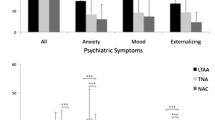Summary
One hundred alcoholics participated in a 6-week inpatient and a 6-week outpatient therapy programme and a 6-month and 18-month follow-up. Major goals of the study were a descriptive analysis of the course of illness over time, the evaluation of the effects of therapy in general and concerning the specific effects of additional (A) systematic inclusion of the key relative versus (B) systematic involvement in self-help, and identification of predictors for relapse. While therapy as such was quite effective and resulted in significant changes in symptomatology and the scores on personality scales, the additional involvement of the key relative showed no substantial additional treatment effects. Partnership interactions showed a deterioration during therapy, with temporary increased frictions. Based on conservative calculations, 40% of all patients remained abstinent until the 6-month follow-up and 30% until the 18-month follow-up.
Similar content being viewed by others
References
Azrin NH, Sisson RW, Meyer R, Goldey M (1982) Alcoholism treatment by disulfiram and community reinforcement therapy. J Behav Ther Exp Psychiatry 13:105–112
Booth BM, Yates WR, Petty F, Brown K (1990) Longitudinal characteristics of hospital use before and after alcoholism treatment. Am J Drug Alcohol Abuse 16:161–170
Bowers TG, Al-Redha MR (1990) A comparison of outcome with group/marital and standard/individual therapies with alcoholics. J Stud Alcohol 51:301–309
Brown GW, Rutter M (1966) The measurement of family activities and relationships: a methodological study. Hum Relat 19:241–263
Costello RM, Biever P, Baillargeon JG (1977) Alcoholism treatment programming: historical trends and modern approaches. Alcohol Clin Exp Res 1:311–318
Derogatis LR, Lipman RS, Covi L (1973) SCL-90: An outpatient psychiatric rating scale — preliminary report. Psychopharmacol Bull 9:13–17
Emrick CD (1974) A review of psychologically oriented treatment of alcoholism. I. The use and interrelationship of outcome criteria and drinking behaviour following treatment. Q J Stud Alcohol 35:523–549
Feuerlein W, Küfner H, Ringer CH, Antons K (1979). Münchner Alkoholismustest (Manual). Beltz Test, Weinheim
Feuerlein W, Küfner H (1989) A prospective multicentre study of impatient treatment for alcoholics: 18- and 48-month follow-up (Munich evaluation of alcoholism treatment, MEAT). Eur Arch Psychiatr Neurol Sci 239:144–157
Fichter MM, Postpischil F (1985) Behavioral family therapy in alcoholism. In: falloon I (ed) Handbook of Behavioral Family Therapy. Guilford Publications, New York
Fichter MM, May F, Postpischil F (1983) Ein stationäres Kurzzeit-therapiemodell auf der Suchtstation der Psychiatrischen Universitätsklinik München. Eine Bilanz über das erste Jahr. In: Schrappe O (ed) Methoden der Behandlung von Alkohol-, Drogen- und Medikamentenabhängigkeit. Schauttauer, Stuttgart, pp 171–179
Fichter MM, Frick U (1992) Therapie und Verlauf von Alkoholabhängigkeit. Springer, Heidelberg Berlin New York
Hahlweg K (1979) Konstruktion und Validierung des Partnerschaftsfragebobens PFB. Z Klin Psychol 8:17–40
Hoellen BM, Hoellen B (1985) Neue Ergebnisse der Alkoholismustherapie: Ein Überblick. Suchtgefahren 31:402–413
Kaufman E, Pattison EM (1982) The family and alcoholism. In: Pattison EM, Kaufman E (eds) Encyclopedic Handbook of Alcoholism. Gardner Press, New York, pp 663–673
Kreisman DE, Simmens SJ, Joy VD (1979) Rejecting the patient: preliminary validation of a self-report scale. Schizophrenia Bulletin 5/2:220–222
Lienert GA (1978) Verteilungsfreie Methoden in der Biostatistik. Vol. II. Anton Hain, Meisenheim am Glan, pp 1246–1248
Loosen PT, Dew BW, Prange AJ (1990) Longterm predictors of outcome in abstinent alcoholic men. Am J Psychiatry 147:1662–1666
McCrady B, Noel N, Abrams D, Stout R et al. (1986) Comparative effectiveness of three kinds of spouse involvement in outpatient behavioral alcoholism treatment. J Stud Alcohol 47:459–467
McCrady BS (1989) Outcomes of family-involved alcoholism-treatment. Recent Dev Alcohol 7:165–182
McNabb J, Der-Karabetian A, Rhoads J (1989) Family involvement and outcome in treatment of alcoholism. Psychol Rep 65:1327–1330
Midanik LT (1988) Validity of self-reported alcohol use: a literature review and assessment. Br J Addict 83:1019–1029
Miller WR, Hester RK (1980) Treating the problem drinker: Modern approaches. In: Miller WR (ed) The addictive behaviours: treatment of alcoholism, drug abuses, smoking and obesity. Pergamon, Oxford, pp 11–14
Monti PM, Abrams DB, Binkoff JA, Zwick WR, Liepman MR, Nirenberg TD, Rohsenow DJ (1990) Communication skills training, communication skills training with family and cognitive behavioral mood management training for alcoholics. J Study Alcohol 51:263–270
Moos RH, Moos B (1984) The process of recovery from alcoholism: III. Comparing functioning in families of alcoholics and matched control families. Q J Stud Alcohol 45:111–118
O'Farrell TJ, Birchler GR (1985) Marital relationships of alcoholic, conflicted and nonconflicted couples. Paper presented at the Annual Convention of the American Psychological Association (August 1985). Los Angeles, Calif.
O'Farrell TJ, Cutter HSG (1979) A proposed behavioral couples group for male alcoholics and their wives. In: Upper D, Ross SM (eds) Behavioral group therapy: An annual review, Research Press, Champaign, Ill., pp 277–298
O'Farrell TJ, Cutter HSG, Floyd FJ (1985) Evaluation behavioral marital therapy for male alcoholics: effects on marital adjustment and communication from before to after therapy. Beh Therapy 16:147–167
O'Farrell TJ, Cutter HSG, Choquette KA, Floyd FJ, Bayog RD (1992) Behavioral marital therapy for male alcoholics: marital and drinking adjustment during the two years after treatment. Behav Ther 23:529–549
Parker G (1983) Parental overprotection: A risk factor in psychosocial development. Grune & Stratton, New York
Regier DA, Boyd JH, Burke JD, Rae DS, Myers JK, Kramer M, Robins LN (1988) One-month prevalence of mental disorders in the United States. Arch Gen Psychiatry 45:977–968
Robins LN, Helzer JE, Weissman MM, Orvaschel H, Gruenberg E, Burke JD (1984) Lifetime prevalence of specific psychiatric disorders in three sites. Arch Gen Psychiatry 41:949–958
Shaw GK, Waller S, McDougall S, MacGarvie J, Dunn G (1990) Alcoholism: A follow-up study of participants in an alcohol treatment programm. Br J Psychiatry 157:190–196
Vaughn CE, Leff JP (1976) The measurement of expressed emotion in the families of psychiatric patients. Br J Soc Clin Psychol 15:157–165
Zerssen D von (1976) Beschwerdenliste. Beltz Verlag, Weinheim
Author information
Authors and Affiliations
Rights and permissions
About this article
Cite this article
Fichter, M.M., Frick, U. The key relative's impact on treatment and course of alcoholism. Eur Arch Psychiatry Clin Nuerosci 243, 87–94 (1993). https://doi.org/10.1007/BF02191570
Received:
Issue Date:
DOI: https://doi.org/10.1007/BF02191570




